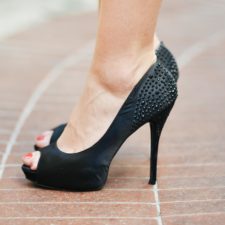
A foot is supported on three main points: heel and first and third metatarsal bone. A high heel shoe forces the foot to keep the position that is far from being natural, thus if you like stiletto shoes, your footwear …

A foot is supported on three main points: heel and first and third metatarsal bone. A high heel shoe forces the foot to keep the position that is far from being natural, thus if you like stiletto shoes, your footwear should be well fitted and comfortable.
The height of the heel also matters and should be fitted to the length of the foot. 10-cm stiletto shoes are a large burden for a short foot of for example 35 – the entire weight of the body is then carried by toes. Size 40 allows a higher heel, but potential risks should be kept in mind. When putting on a high heel the foot heel is raised, and body weight overloads the forefoot, therefore wearing high stiletto shoes is associated with the following risks: in the middle of the metatarsus, which is not naturally adapted to carrying heavy loads, skin may become calloused, ligaments also become overloaded, as well as Achilles tendon may be cramped. Avoid narrow and also very high heels that prevent your ankles from being stabilised. Ligament stabilising this movement are then forced to an extremely hard work.
On the other hand, when wearing stiletto shoes on a daily basis, your foot, calf and thigh muscles are adapted to overloading the forefoot, and a sudden change to flats may cause heel and calf pain.
Burning soles – complaints of those wearing high heels
Burning soles are usually caused by foot overload caused by regular wearing of high heels. It leads to foot deformities – metatarsal bones move aside which consequently causes transverse flatfoot and acute burning when walking or standing for a long time. This complaint may be alleviated by using gel cushions that you put under the forefoot. However, in such a case, it is better to limit stiletto shoes. Orthopaedists warn that, apart from deformities, stiletto shoes cause calf muscle cramps, disturbing the action of the muscle pump pushing the blood from legs towards the heart. In extreme cases, this overload may be transferred to knees, hips and lumbar spine.